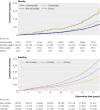Combined effects of overweight and smoking in late adolescence on subsequent mortality: nationwide cohort study
- PMID: 19244221
- PMCID: PMC2651106
- DOI: 10.1136/bmj.b496
Combined effects of overweight and smoking in late adolescence on subsequent mortality: nationwide cohort study
Abstract
Objective: To investigate the combined effects on adult mortality of overweight and smoking in late adolescence.
Design: Record linkage study with Cox proportional hazard ratios adjusted for muscle strength, socioeconomic position, and age.
Setting: Swedish military service conscription register, cause of death register, and census data.
Participants: 45 920 Swedish men (mean age 18.7, SD 0.5) followed for 38 years.
Main outcome measures: Body mass index (underweight (BMI <18.5), normal weight (18.5-24.9), overweight (25-29.9), and obesity (>or=30)), muscle strength, and self reported smoking (non-smoker, light smoker (1-10 cigarettes/day), heavy smoker (>10/day)) at mandatory military conscription tests in 1969-70. All cause mortality.
Results: Over 1.7 million person years, 2897 men died. Compared with normal weight men (incidence rate 17/10 000 person years, 95% confidence interval 16 to 18), risk of mortality was increased in overweight (hazard ratio 1.33, 1.15 to 1.53; incidence rate 23, 20 to 26) and obese men (hazard ratio 2.14, 1.61 to 2.85; incidence rate 38, 27 to 48), with similar relative estimates in separate analyses of smokers and non-smokers. No increased risk was detected in underweight men (hazard ratio 0.97, 0.86 to 1.08; incidence rate 18, 16 to 19), though extreme underweight (BMI <17) was associated with increased mortality (hazard ratio 1.33, 1.07 to 1.64; incidence rate 24, 19 to 29). The relative excess risk due to interaction between BMI and smoking status was not significant in any stratum. Furthermore, all estimates of interaction were of small magnitude, except for the combination of obesity and heavy smoking (relative excess risk 1.5, -0.7 to 3.7). Compared with non-smokers (incidence rate 14, 13 to 15), risk was increased in both light (hazard ratio 1.54, 1.41 to 1.70; incidence rate 15, 14 to 16) and heavy smokers (hazard ratio 2.11, 1.92 to 2.31; incidence rate 26, 24 to 27).
Conclusions: Regardless of smoking status, overweight and obesity in late adolescence increases the risk of adult mortality. Obesity and overweight were as hazardous as heavy and light smoking, respectively, but there was no interaction between BMI and smoking status. The global obesity epidemic and smoking among adolescents remain important targets for intensified public health initiatives.
Conflict of interest statement
Competing interests: None declared.
Figures



References
-
- Popkin BM, Conde W, Hou N, Monteiro C. Is there a lag globally in overweight trends for children compared with adults? Obesity (Silver Spring) 2006;14:1846-53. - PubMed
-
- Ogden CL, Carroll MD, Curtin LR, McDowell MA, Tabak CJ, Flegal KM. Prevalence of overweight and obesity in the United States, 1999-2004. JAMA 2006;295:1549-55. - PubMed
-
- Adams KF, Schatzkin A, Harris TB, Kipnis V, Mouw T, Ballard-Barbash R, et al. Overweight, obesity, and mortality in a large prospective cohort of persons 50 to 71 years old. N Engl J Med 2006;355:763-78. - PubMed
-
- Ajani UA, Lotufo PA, Gaziano JM, Lee IM, Spelsberg A, Buring JE, et al. Body mass index and mortality among US male physicians. Ann Epidemiol 2004;14:731-9. - PubMed
-
- Jee SH, Sull JW, Park J, Lee SY, Ohrr H, Guallar E, et al. Body-mass index and mortality in Korean men and women. N Engl J Med 2006;355:779-87. - PubMed
Publication types
MeSH terms
LinkOut - more resources
Full Text Sources
Other Literature Sources
Medical
